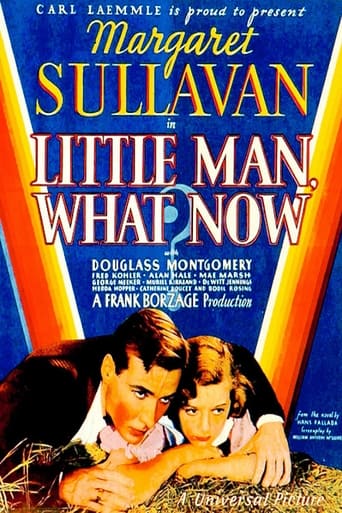bkoganbing
I see that the German cinema did a version of Little Man What Now a year before this Universal Picture came out. Depending on exactly when Dr. Goebbels took over their movie industry the message would have been far more polemic than here. I could see this as good material for either a Nazi inspired film or a left wing one.But Frank Borzage as director always seems to concern himself with the plight of young lovers, the truly innocent of the world and how forces around them are buffeting their chances at happiness. Which seems to be a capital sin in Borzage films.A lot similarity between this one and later Borzage works like Three Comrades and The Mortal Storm which also starred Margaret Sullavan. In Little Man What Now Douglass Montgomery and Margaret Sullavan are a pair of young marrieds who just can't seem to get traction enough for Montgomery to earn a living and support Sullavan and the baby coming. As things go from bad to worse Montgomery is tempted to seek radical politics of some kind.My favorite scene in the film concerns poor Montgomery waiting on a self centered cinema star in the department store where he is currently employed. Alan Mowbray is unforgettable in that one scene. Interesting showing a the indulgences of a selfish man can have such an effect as Montgomery's job is on the line.Even now too many of us live two paychecks from the gutter and too many of us are tempted by demagogues as a result. In that way Little Man What Now is still a very relevant film.
Daryl Chin (lqualls-dchin)
Frank Borzage was one of the prize directors at the Fox Studio in the late 1920s; he became the first director to win the Academy Award for SEVENTH HEAVEN in 1927, one of the essential romances of the silent cinema. But by 1932, William Fox was running into trouble, and the finances of Fox were shaky. Borzage had won his second Oscar for Best Director in 1931 for the Fox production of BAD GIRL; two years later, he was working for Mary Pickford's own production company (SECRETS), Paramount (A FAREWELL TO ARMS), Columbia (MAN'S CASTLE and NO GREATER GLORY) and Universal (LITTLE MAN, WHAT NOW?). LITTLE MAN, WHAT NOW? was based on a German novel by Hans Falleda, which had been made into a movie in Germany in 1933. (I haven't seen the German movie.) But LITTLE MAN, WHAT NOW? would be the follow-up film for Universal's new star, Margaret Sullavan, who had made an impressive debut in ONLY YESTERDAY, directed by John M. Stahl. She was known for being temperamental, and she refused several projects before she agreed to star in LITTLE MAN, WHAT NOW?In some ways, LITTLE MAN, WHAT NOW? is the quintessential Frank Borzage movie, with many scenes and themes which echo his earlier films. There is the young couple, struggling to survive severe economic hardship; there are the effects of the Great War, leaving many with few opportunities. There is even the scene where the heroine appears in a shimmering gown, a radiant moment that is a respite from the general squalor and/or misery (this scene can be found in SEVENTH HEAVEN, in MAN'S CASTLE, in THREE COMRADES). LITTLE MAN, WHAT NOW? takes its young couple (Sullavan and Douglass Montgomery) through various strata of the struggling working class in Germany during the worldwide economic downturn of the early 1930s. Along the way, they encounter a variety of characters, including Muriel Kirkland as the hideously overprivileged daughter of an employer, Catherine Doucet as Montgomery's giddy stepmother, and Alan Hale as her hearty, possibly shady friend. Through it all, Sullavan's empathetic, luminous performance provides the film with its beacon of hope in the midst of turmoil and strife. This would be the first of four collaborations between Margaret Sullavan and Frank Borzage. (Just for the record, it should be stressed that this film was made at Universal Studios, NOT MGM, where Borzage would start working in 1937; Universal has been one of the studios which has been notoriously problematic in terms of getting their films on various home-video formats, so it's no wonder that LITTLE MAN, WHAT NOW? is unavailable, but asking for MGM to release a Universal film on DVD is an object lesson in futility.)
classicflm
Margaret Sullavan was never more beautiful in this mega tearjerker. Even if she has to act opposite the unappealing Douglass Montgomery, the films works. Wonderfully photographed, and superb acting by all makes this movie a must see.
oliverkneale
One of the most heartbreaking, swoon-inducing film experiences I've ever had is 1934's "Little Man, What Now?"It's about a young couple, with a child, struggling against poverty and a steady stream of bad luck in early 1930's Germany. It's an American film, but at times it almost plays like a piece of European cinema. The atmosphere is thick and the story isn't afraid to drift into areas that are a bit dark (and daring in a pre-code sense). It has a sentimental streak for sure, but the sentiment is never turned on at the expense of intelligence.Another stand out quality of the film is it's almost painfully gorgeous cinematography. The world of the film is like a dream or like something from a storybook. Sunlight shines against water and trees and grass with a pristine silvery glow. Faces are shown in the most lovely light. Margaret Sullavan, especially, is shot in a way that practically makes you fall in love with her.This is a true jewel of obscure 1930's cinema, rarely shown and, as of this writing, not available on any home video format. See it the first chance you get. It is a must for the classic movie enthusiast who feels like they've seen everything.




